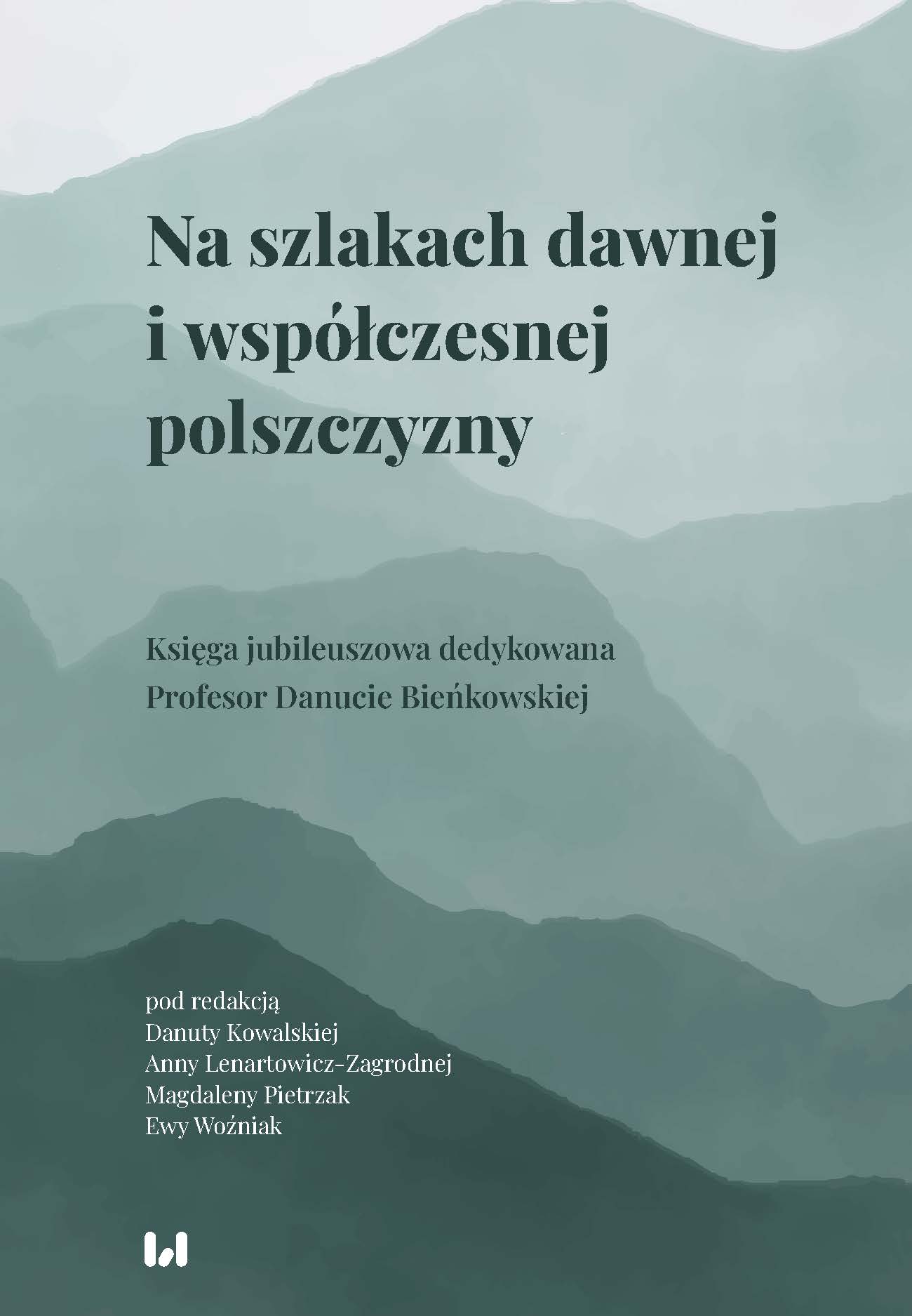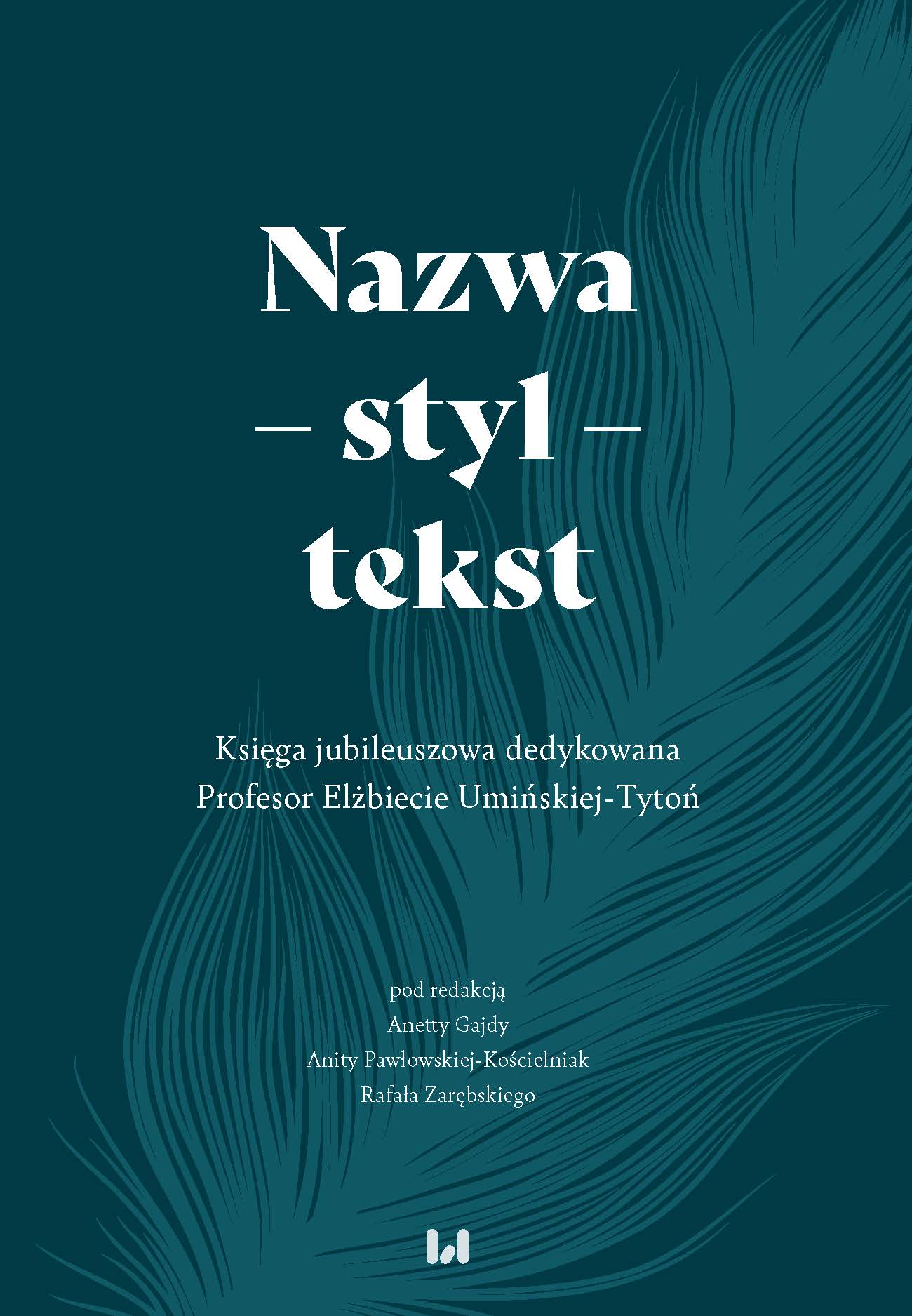




Keywords: lexis; onomastics; anthroponymy; historical Polish; modern Polish
The aim of the article is primarily to present the etymology of the names and surnames of the Jubilarian as well as the way these onimas function both historically and today. The source material for analysis was excerpted from dictionaries of the Polish language: etymological, general (explanatory: historical and contemporary dictionaries), phraseological, and onomastic.
More...
Keywords: Polish biblical style; stylistics; the history of Polish language
The article presents the results of the research of Danuta Bieńkowska, a linguist from Łódź, on the issue of Polish biblical style. For this purpose the author recalled the main results and findings made by Bieńkowska in the monograph Polish Biblical Style (2002) published 20 years ago, which was the first attempt at a synthetic approach to this issue in the Polish language. The author of the study drew attention to three dimensions of this work, which, from the contemporary perspective, have the following character: 1. permanent, 2. constituting a field for discussion and 3. opening perspectives for further research in this field.
More...
Keywords: Polish Renaissance New Testament renderings; Polish quivalents of Greek φύραμα or Latin massa; textual distribution of equivalents; tranlation strategies
The meaning of the Greek lexeme φύραμα (or Latin massa) in Rom 11:16, 1 Cor 5:6 and Gal 5:9 - ‘any substance mixed with water and kneaded; a mass, lump’ – only generally indicates the referent. Therefore, in Polish biblical Renaissance translations, it has several synonymous equivalents: ciasto – przymieszanie – rozczyna – rozmieszenie – zaczynienie – zadziałanie – zamies – zamieszanie.In the New Testament of Jakub Wujek from 1593 (Wuj93) there are three of them: ciasto, zaczynienie, zadziałanie. Textual distribution of equivalents of Greek φύραμα or Latin massa in Wuj93 is a result of a philological translation strategy, which consits in revealing the meaning of the Latin translation text basis also by confronting it with the Greek New Testament text. The equivalent ciasto is attested in earlier Catholic renderings of 1556 and 1561. The other two equivalents are attested in Protestant New Testament renderings –zaczynienie in the Anti-Trinitarian one from 1577, zadziałanie in the Calvinist one from 1563. The textual provenance of these equivalents are less relevant to their semantic adequacy in specific biblical contexts.However, in the New Testament in the Bible of Jakub Wujek from 1599 (Wuj99) in all biblical contexts only one equivalent was used: ciasto, attested in the earlier Catholic renderings. The Jesuit censorship commission led by Stanisław Grodzicki, which revised Jakub Wujek's translation, chose a literal translation strategy. The rendering should be strictly in line with the Latin Clementine Vulgate (1592). As a result, the contextual synonymous equivalents of Latin massa (i.e. ciasto, zaczynie, zadziałanie) were replaced with one lexeme only (i.e. ciasto).
More...


Keywords: Polish lexicography; Polish and Slavic philology; Polish 16th and 17th century Bible Translations; Leopolita Bible; Radziwiłł Bible; Budny Bible; Wujek Bible; Murzynowski New Testament; Wróbel Psalter
In his “Słownik języka polskiego” (vols 1-6, Warsaw 1807-1814) S. B. Linde included a large number of quotations from Polish 16th and 17th century Bible translations. They illustrate the semantic meaning of numerous words of the Polish language but also show alternative translation choices thanks to quoting parallel extracts from two or more Bible versions. Linde not only rendered great services for Polish and Slavic lexicography, but also pioneered philological research on Polish Bible translations. In addition, the lexicographer was interested in the translations of Luther and Skoryna, Lithuanian bibles and the Gothic New Testament of Ulfilas.
More...
Keywords: lexis; onomastics; anthroponymy; historical Polish; modern Polish
The aim of the article is primarily to present the etymology of the names and surnames of the Jubilarian as well as the way these onimas function both historically and today. The source material for analysis was excerpted from dictionaries of the Polish language: etymological, general (explanatory: historical and contemporary dictionaries), dialect, phraseological, and onomastic.
More...
Keywords: anthroponomastics; system of naming people in Poland; meaning; origin and history of the name Elżbieta
Elżbieta is the name of biblical origin, and its appearance in Polish anthroponymy should be associated with the expansion of Christian culture, which in the Middle Ages covered almost all of Europe. It is a name taken from the Hebrew language. In Poland this name has been known since the 13th century. The first record of the name can be found in the document from 1198, then in the form Helisabeth: „Mesacho, Pollonie dux et prima uxor eius Helisabeth. For many centuries it was the name of a very popular, but since the sixties of the 20 th century, its popularity is decreasing.
More...
Keywords: onomastics; apocrypha; stylistics; speech genre; discourse
The article concerns the possibilities of Old-Polish apocrypha analysis from onomastic perspective. The research certifies that proper names observed in contexts of text, genre and most of all discourse can bring interesting answers to a question of apocrypha character. Two main functions of proper names are distinguished: speech genre forming and fear eliciting. One can affirm that the first function is connected with structural and semantic aspects of apocrypha speech genre, whereas the second one relates to pragmatic and partly style levels of the speech genre pattern. However both functions are important in the analysis of discourse level which is significant in the case of research on apocrypha understanding as an Old-Polish culture phenomenon.
More...
Keywords: geograpical names; folk names; the Polish language; naming convention
The author presents Vincent Pol’s (1807‒1872) fascination with Polish folk names from a geographical and botanical domain. Pol argues that such names are well-suited and constitute a source of information about the world. He postulates that regional and folk names should be included in academic descriptions.
More...
Keywords: linguistics; onomastics; toponymy; memoire
The aim of the paper is to indicate functions of toponyms in the text of the 19th century memoir written by Julian Borzym — a Polish nobleman coming from Podlasie (north-east part of Poland). Local and field names perform a informative function in the text. They create a geographical background for the presented events, show topography of towns and villages, indicate a position and status of described people (names of owned or leased properties). The informative function is connected with the locative one, that indicates the position of presented toponyms in time (e.g. names connected with historical events) and space, and also the affiliation to a given region which can be seen in the characteristic morphological features such as suffixes -(ow)izna/-yzna (Wierzbowizna, Piszczatowizna, Malinowszczyzna), -k instead of -ek in the forms of the genitive case (z Rzepk, z Rosk, do Niemierk, do Kobosk).
More...
Keywords: larch; spruce; dendronyms; Lemko dialects
The article is an attempt to solve the genesis of the Lemko word skwirt (present in the name of the village of Skwirtne in Low Beskids). Based on the available written sources (from Slovak, Ukrainian and Polish areas, Polish, Ukrainian and Belarusian lexicons, as well as correspondence with famous botanicts, the author tries to explain not so much the ethymology of the lexeme (which is know), but the reasons for a specific intersection on a specific area (Lemko region) of the names of the trees: spruce and larch.
More...
Keywords: urban naming ; unofficial circulation ; Bydgoszcz
The article is intended to be a research reconnaissance, an attempt to face the variable and unstable resource of unofficial urban onims, to signal methodological problems that may arise during proper research, to show the possibilities and limitations of the researcher of this issue. Already from a superficial analysis prepared on a small set of colloquial urban names, difficulties arise related to the generacy, hermetic, openness of the set and fluidity of names different from official ones. The analysis led to the following conclusions that urban colloquial nomenclature arises by modifying official names through ellipses, phonetic changes, inflectional changes, etc. — existing names or through doublets — previous names, changed; and without reference to the circulation of official names in the form of urbanonyms created on the basis of associations, language games or language jokes.
More...
Keywords: urban toponymy; sport; city
The article presents the names of Lodz streets with a sports origin and proper names of sports facilities. The material was excerpted from the Słownik nazewnictwa miejskiego Łodzi and from the website of the City of Łódź Office. The names were subjected to a semantic and structural analysis.
More...
Keywords: political communication; onomastics; proper noun; definite description; chrematonim
The article deals with selected features of political communication. Its purpose is to analyze the means of secondary nomination in relation to persons, objects, human collectives, and the means of primary and secondary nomination in relation to names of human collectives and events. The author analyzes proper names and descriptions from the last 20 years, during which she observed the political discourse in the media. Representative examples are given in the article. The analysis of the entire material shows that the acts of nomination play an important role in political communication. They are used to build an image, shaping a positive attitude towards the object or its discredit. Secondary changes of names are not uncommon, which are a signal of a different position and polemics. Specific descriptions that identify individual objects but do not lose their motivation deserve special attention. Thanks to this, they perform a persuasive function.
More...
Keywords: proper names; Polish spelling; capital letters; spelling regulation
The paper deals with the problem of the use of capital letters in relation to two selected orthographic rules: the spelling of the names of titles and the names of objects in urban space. It was shown that the current orthographic rules are to a great extent inconsistent and are the result of arbitrary (and, more importantly, incorrect) interpretation of the status of genre names. The postulate of an overriding orthographic rule was formulated, which would require that all words in the structure of proper names be spelled with capital letters. Such a solution would have a systemic value, simplifying the existing chaos and unnecessary detailing of regulations.
More...
Keywords: lexicography; tematic classification
The article describes the religious vocabulary and the way it is presented in the Great Dictionary of the Polish Language of the Polish Academy of Sciences. The author characterizes the main conceptual circles in which the religious vocabulary is focused, and analyzes the chronological, stylistic and pragmatic qualifiers used in the description. She draws attention to new lexical units, not listed in previous dictionaries.
More...